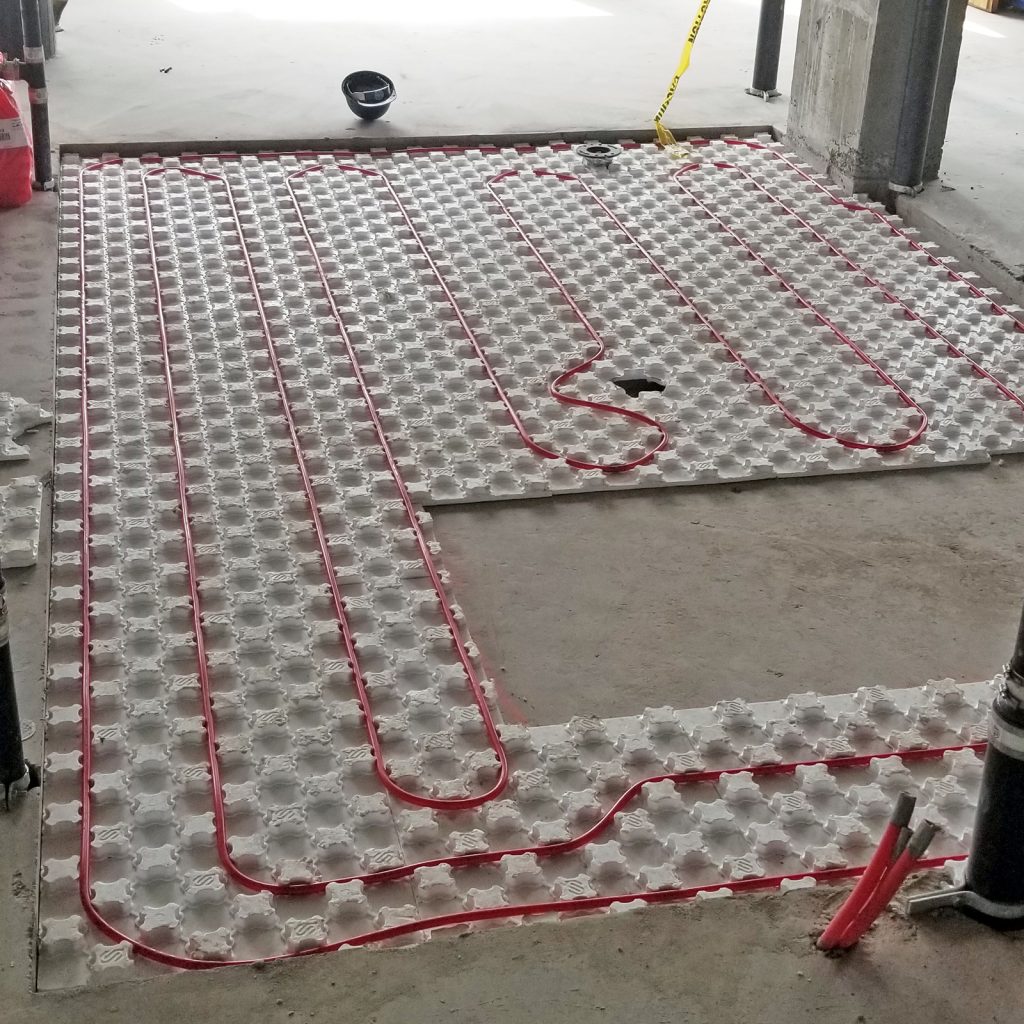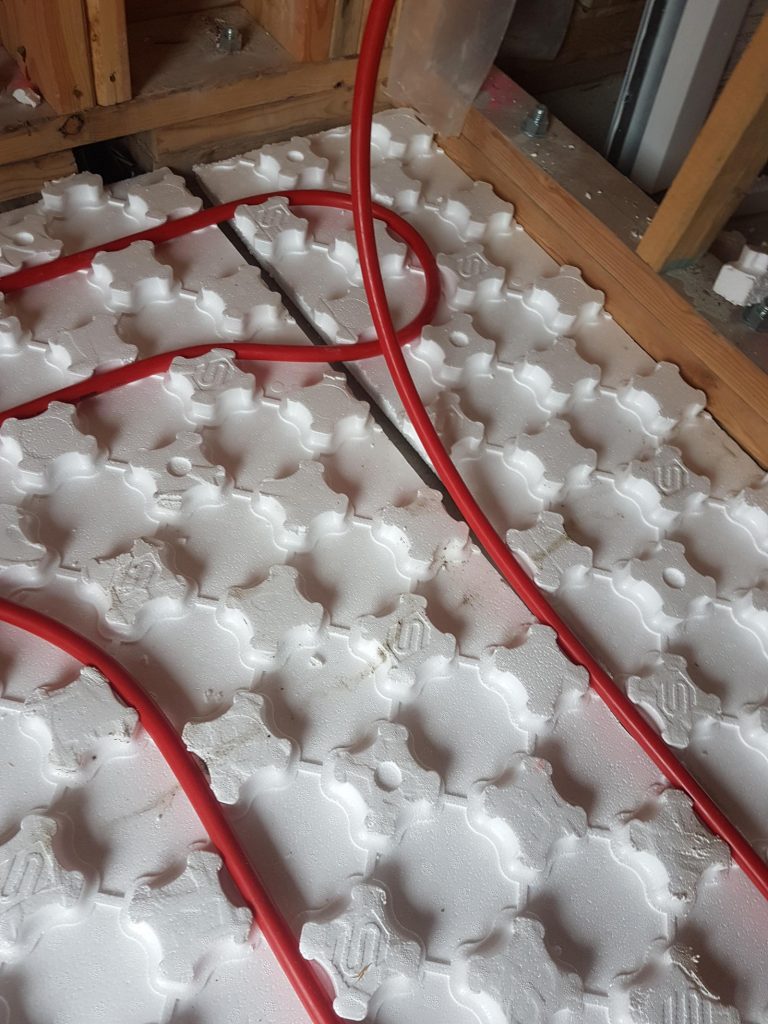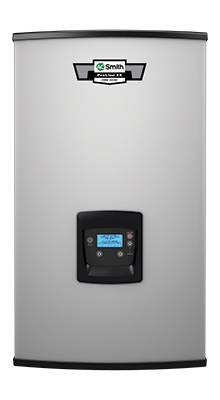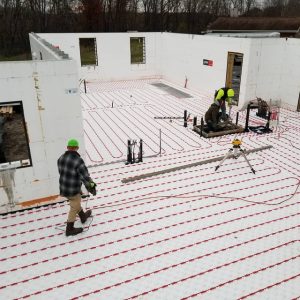By keeping your feet warm, Hydronic Radiant Floor Heating (RFH) systems let you comfortably lower your thermostat to 68 degrees instead of 72, shaving about 10% off your energy bills. That’s why these systems are such an excellent investment for any basement that you’ll use as a living space.
In this post, we’ll talk about the 2 typical stages and essential factors to consider if you’re about to retrofit your basement with RFH.
Rough-In Phase
Insulation
This first phase of the retrofit is where you’ll lay down the piping that will circulate hot water under the floors.
The first item to consider is insulation — without an adequate insulative layer beneath the pipes, a good portion of the precious heat will escape downward instead of rising. However, in a retrofit of an existing basements preserving ceiling height and headroom is also a key consideration.
This is why you should aim to have an insulation board of at least R-4 or R-6 under the pipes – a decent amount of insulation while preserving ceiling height.
The next question to settle is the type of insulation you should use.

A flat rigid foam board that meets the R-value and compressive strength requirements may work. However, using a flat base for the pipes translates into a tedious, costly installation process, where the tubes must be stapled in place every few feet.
Alternatively, you can use a product like Heat-Sheet’s retrofit panels, which offer a multidirectional tubing channel grid to facilitate easy installation of hot water tubing. Heat-Sheet’s nodules hold the pipes in place, so your team only needs to staple them at the bends — this reduces the overall labor hours required for rough-in.
Piping
Most experts recommend Pex tubing with a ½-inch diameter for residential applications. The spacing ranges from 6 to 12 inches but depends on the heating load calculations, which a licensed HVAC professional can provide for you. The flooring type is another factor that will affect spacing — if you’re using tile, you’ll want to opt for 6-inch spacing to avoid leaving cold spots on the floor.
While the costs may vary by region, ½-inch Pex tubing supply will typically set you back $0.55 per linear foot, while installation with a product like Heat-Sheet will add perhaps another $0.20/foot to the total costs.


Don't miss a thing!
Subscribe for exclusive content, insider industry news and limited edition webcasts.
Activation Phase
Before your hydronic RFH system can go live, you must consider the source of hot water. There are 3 options: an indirect water heater, a boiler, and a combi boiler.
Indirect Water Heater
This device comprises a water storage tank with a heat exchanger and is an excellent option for hydronic radiant floor heating, as it keeps the water temperatures low. It’ll supply about 40-60 gallons of hot water for your heating system, but you won’t be able to also use it for other domestic needs — for health reasons, it’s imperative to keep the potable and heating water separate.
Conventional Boiler
These traditional boilers can be used for both your radiant heating system and potable water. The drawback is that they require lots of storage space for water.
Combination (Combi) Boiler
Combis are high-efficiency modern water heating systems that can supply hot water on demand. They’ll keep the potable and heating water separate without requiring storage space (combis are the most space-efficient option).
Their major downside is that they can only produce about 3.75 gallons per minute. Thus, for large, busy households, this might mean lower pressure in the taps and showers.
Apart from the heating method, you’ll also need to consider these essential items before you can operate the RFH system:
- Checking for adequate gas lines
- Proper venting
- Installing the necessary manifolds
A licensed HVAC technician can help you out with these items to ensure a smooth activation. The typical total cost to activate an RFH system in a 1,500ft2 basement is about $10,000 to $15,000.

How Will You Heat The Main Floor?
Hydronic RFH works just as well for the main floor of a home. You can easily rough-in Pex tubing beneath your subfloor with Heat-Sheet’s low-profile retrofit panels.
If you do, don’t forget that your heating load will increase, and you’ll need a higher-capacity water heating system to operate the system on multiple floors.
Wrapping It Up
RFH offers an efficient, healthy way to keep your basement — and the entire home — warm.
There are a few essential factors to keep in mind while roughing in and activating the system, but with a handy product like Heat-Sheet and a licensed HVAC engineer’s assistance, these steps are pretty straightforward.
Pros and Cons of Radiant Floor Heating in a Garage or Workshop
If you’re thinking about heating your garage or workshop, radiant floor heating can be an efficient and practical option. With its ability to provide consistent
Streamlining Radiant Heating Installation with Heat-Sheet Heavy – A Professional’s Guide (Part 2)
In our March post, we explored the initial steps of installing radiant heating with Heat-Sheet Heavy, guided by Kyle Stumpenhorst from RR Buildings. In this
Streamlining Radiant Heating Installation with Heat-Sheet Heavy: A Professional’s Guide
In today’s construction industry, efficiency and reliability are paramount. Through that lens, Heat-Sheet Heavy presents itself as an essential solution for those in the building






